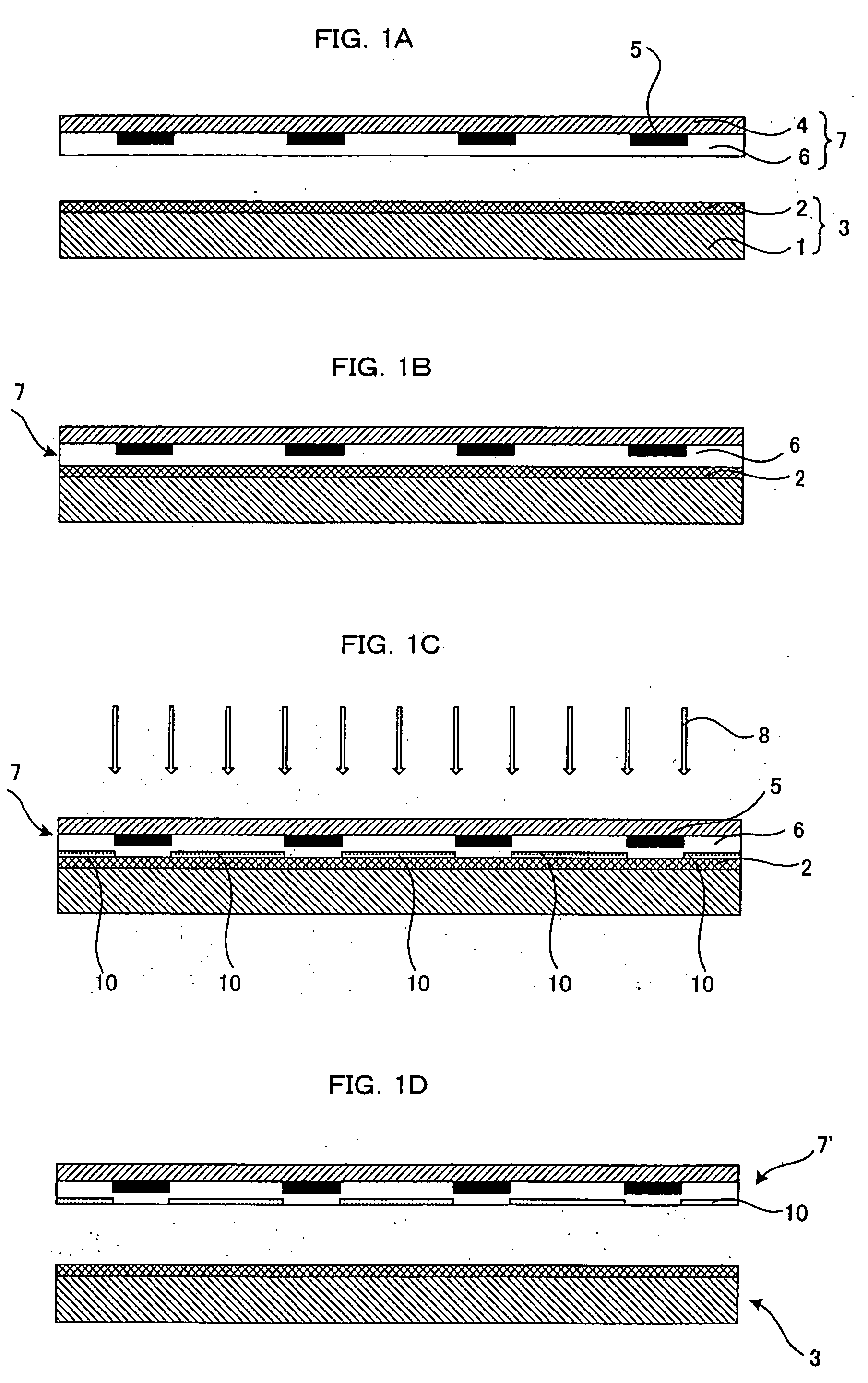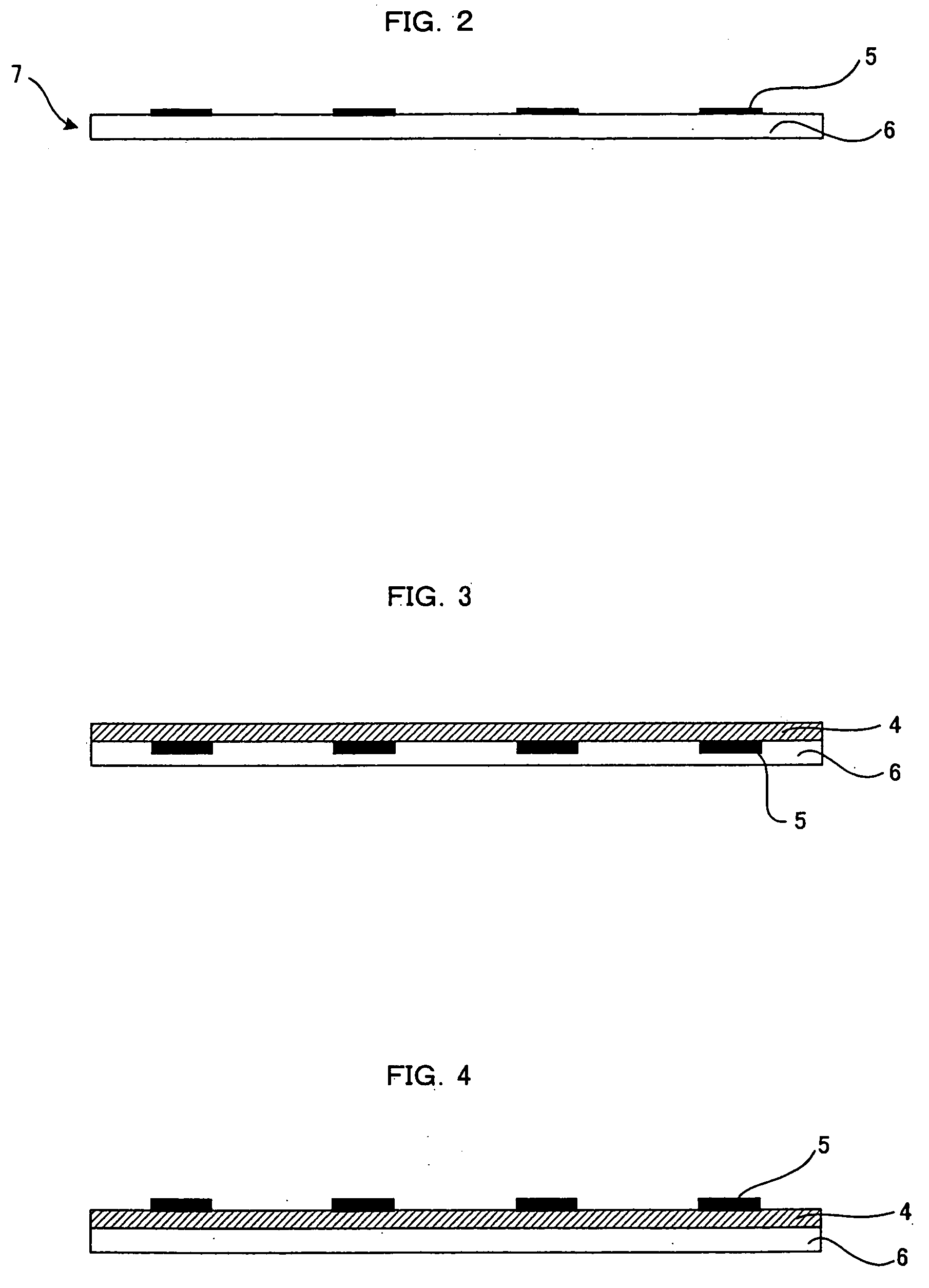Methods for producing pattern-forming body
a pattern-forming body and pattern-forming technology, applied in the field of pattern-forming bodies, can solve the problems of difficulty in forming patterns at a high accuracy, adverse effects on some types of pattern-forming bodies, and associated with positioning accuracy, and achieve high quality, high accuracy, and high precision. the effect of microlenses
- Summary
- Abstract
- Description
- Claims
- Application Information
AI Technical Summary
Benefits of technology
Problems solved by technology
Method used
Image
Examples
embodiment 1
(1) Embodiment 1
[0095] Embodiment 1 of a pattern-forming body substrate of the present invention relates to a pattern-forming body substrate having a characteristic-changeable layer, a light-shading part, and a transparent substrate. Each component is discussed below.
(Characteristic-Changeable Layer)
[0096] A characteristic-changeable layer of this embodiment is discussed first. A characteristic-changeable layer of this embodiment is not limited particularly provided that its characteristics are changed by the effect of a photocatalyst-containing layer described above. For example, the characteristic-changeable layer may be converted to a layer that can be colored by the effect of the photocatalyst by admixing a photochromic material such as spiropyran or an organic dye decomposable by the effect of the photocatalyst with the characteristic-changeable layer.
[0097] It is also possible to use as a characteristic-changeable layer a layer whose adhesiveness to various materials is im...
embodiment 2
(2) Embodiment 2
[0193] Embodiment 2 of a pattern-forming body substrate of the present invention is described below. A pattern-forming body substrate in this embodiment has a characteristic-changeable layer having a self supporting property on which a light-shading part is formed as a pattern.
[0194]FIG. 2 shows an example of a pattern-forming body substrate employed in this embodiment, in which a light-shading part 5 is formed on either surface of a characteristic-changeable layer 6 to form a pattern-forming body substrate.
(Characteristic-Changeable Layer)
[0195] First, a characteristic-changeable layer in this embodiment is discussed. A characteristic-changeable layer in this embodiment is not limited particularly provided that it is a layer whose characteristics are changed by the effect of a photocatalyst-containing layer and which has a self supporting property, and maybe a layer whose color, polarity, or adhesiveness is changed by the effect of a photocatalyst similarly to Em...
example 1
[0253] A fluorine-based silicone was formed as a film whose thickness is 0.1 μm on a quartz glass substrate having a pattern of a 0.2 μm-thick and 20 μm-wide chromium line formed an interval of 100 μm to form a wettability-changeable layer to provide a pattern-forming body substrate.
[0254] The fluorine-based silicone employed here was prepared by admixing 5 g of a fluoroalkylsilane (GE Toshiba Silicones, TSL8233) with 3 g of 1N hydrochloric acid, stirring for 24 hours, subjected to 10-fold dilution with isopropyl alcohol to obtain a coating solution, which was then applied by a spin coating method and dried to form a film.
[0255] On a soda lime glass substrate, ST-K01 (Ishihara Sangyo Kaisha, Ltd.) was applied to provide a photocatalyst-containing layer-sided substrate having a photocatalyst-containing layer whose thickness was 0.2 μm. The substrate was arranged in such a manner that the wettability change layer was facing the photocatalyst-containing layer at the distance of 5 μm,...
PUM
 Login to View More
Login to View More Abstract
Description
Claims
Application Information
 Login to View More
Login to View More - R&D
- Intellectual Property
- Life Sciences
- Materials
- Tech Scout
- Unparalleled Data Quality
- Higher Quality Content
- 60% Fewer Hallucinations
Browse by: Latest US Patents, China's latest patents, Technical Efficacy Thesaurus, Application Domain, Technology Topic, Popular Technical Reports.
© 2025 PatSnap. All rights reserved.Legal|Privacy policy|Modern Slavery Act Transparency Statement|Sitemap|About US| Contact US: help@patsnap.com



